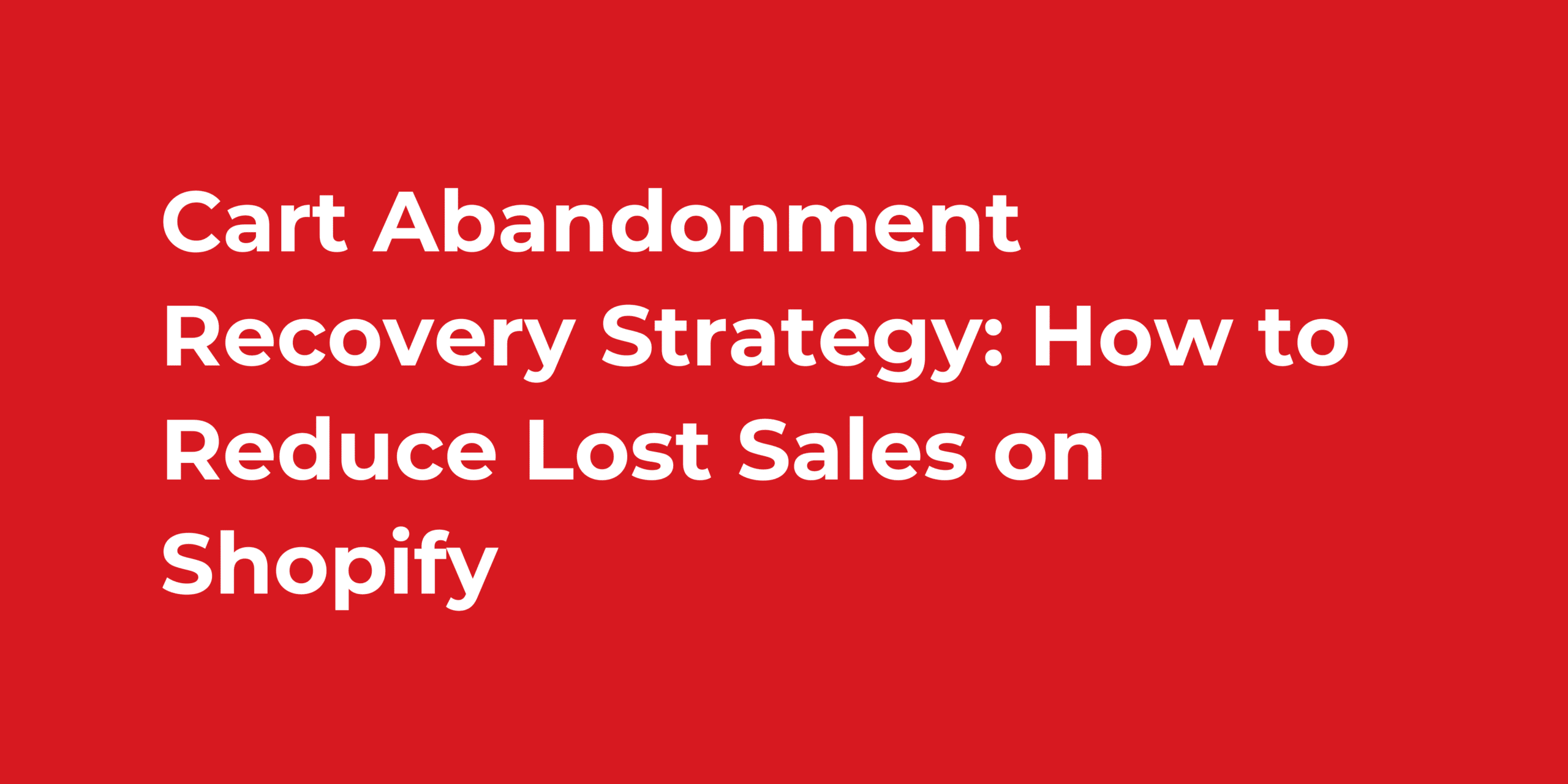It’s Interesting to know that average e-commerce conversion rates are around 2.5-3%. But if you are doing everything right, you can still win the sale around 2-3% of the time. If you want to increase your conversion rate beyond this level, CRO tools can help.
Conversion Rate Optimization generally refers to enhancing the percentage of visitors to a website who perform desired actions, such as making a purchase or signing up for a service. CRO is a core for every e-commerce business, as it maximizes the value of existing traffic and raises the value of revenue and customer satisfaction.
In this blog post, you will understand how to use the best CRO tools for the performance of your e-commerce business and increased website traffic.
How A/B testing tools enhance CRO
A/B testing tools are software applications that enhance online performance by comparing two versions of the same webpage or email, among other marketing materials. In A/B testing, one version is “A,” or the original, while the other is “B,” or the modified version. The tool shows each version to different groups of users simultaneously and tracks how they will react to each of them.
On landing pages, A/B testing can increase conversions by as much as 30%. Data analysis, such as click rates, sign-ups, or purchases, will enable businesses to know which version more persuasively elicits the desired behavior for users. This process allows companies to make decisions based on real user behavior, thereby increasing conversion rates.
To get more details, read our blog post on How to Create Effective E-commerce Landing Pages That Convert.
Optimizely
Optimizely is a strong A/B testing, multivariate testing, and personalization platform. It allows for visual editing, deep analytics, and experimenting across web and mobile platforms. It also has an option of segmenting audiences for targeted experiments.
Optimizely has different packages like content management platforms, content management systems, web experimentation, feature experimentation, personalization, and configured commerce. For pricing, you can request your package, and they will send you complete details.
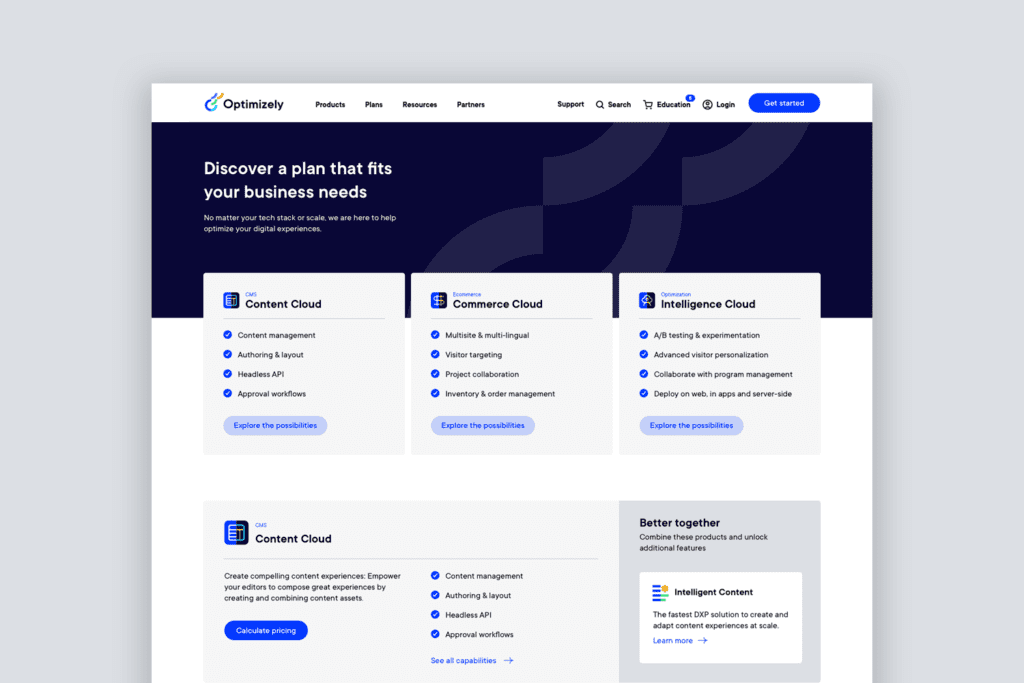
VWO (Visual Website Optimizer)
The VWO is a complete bundle of A/B testing, multivariate testing, heatmaps, and user recordings. It offers detailed insights into user behavior. It can help businesses optimize their websites. Creating and running tests don’t need much expertise in coding, and this requires having a visual editor.
VWO begins with pricing plans around $314 per month for basic plans, moving upward with higher value features and additional testing ability. Special prices are necessary for large organizations on an as-needed basis.
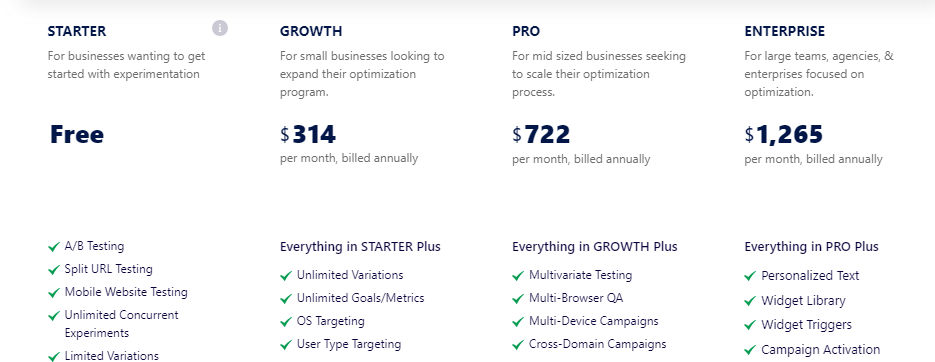
AB Tasty
A/B Tasy helps with A/B testing and personalization, multivariate testing, user segmentation, and real-time reporting for quick analysis of the outcome. You can compare your landing pages to see which one generates the most leads for your business. It helps businesses improve their websites and apps through testing personalization. This makes it easier for businesses to understand what is best for their customers and enhances user experience.
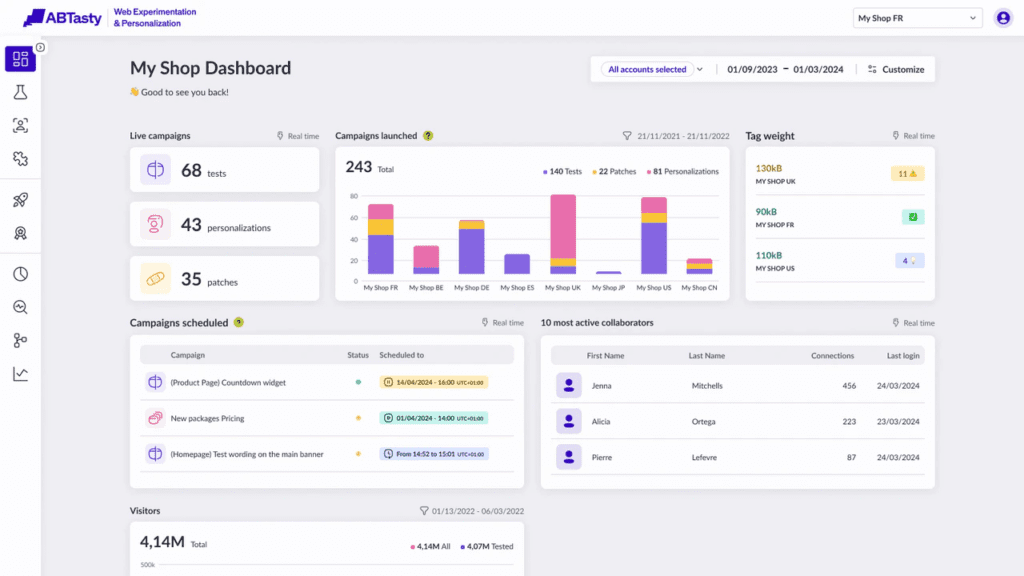
The price is customizable based on the chosen features and type/size of the business. You can create your package and customize prices.
Convert
Landing pages have a 23% signup rate when used as a lead generation tool. Convert focuses on A/B testing and personalization, promising users heavy multi-variate testing capabilities alongside split URL testing. It adds advanced reporting features and targeting options to enhance the user experience; the visual editor makes for comparatively simpler creation and development of design elements.

Convert offers different pricing plans for about $199 monthly, largely targeted toward bigger business users. Pricing is based on the number of unique visitors and some features needed so that larger businesses with higher testing complexity can be accommodated.
Heatmaps tools: an essential for CRO
Heat map tools in CRO are software applications that illustrate user interaction on the website. They give the business better information on how visitors interact with their pages through a color-coded presentation based on data.
These tools follow what happens when a user clicks, scrolls, or moves the mouse and display that on the web pages in the form of colored overlays. The “hot” areas of this series, which are warm with red or orange color, present where users are most engaged, and the “cold” areas, blue or green, show where users engage the least.

Using heat maps, businesses can rapidly determine which parts of a page attract the most attention, which areas users click the most, and how far they scroll. That helps them find weak spots in their pages, such as failing to draw attention to overlooked content or underperforming buttons. Companies will be able to make well-informed decisions regarding the design and layout and how best to place their content to achieve the desired user experience and conversion rate.
Some of the best heatmap tools are discussed below:
HotJar: The leading heatmap tool
Hotjar is a popular heatmap tool that tracks clicks, taps, and scrolls from user interactions on a website. It also visualizes user activity in heat maps, allowing you to see which parts of your site attract the most eyeballs. Additionally, it provides session recordings.
You can watch users navigating your site in real time. Another way of using such tools to gather user insights directly is via feedback tools, such as surveys and polls. Businesses can enhance designs on their websites and increase growth by knowing the behavior of users when it improves the user experience and increases conversion rates.
Hotjar pricing starts from $0, making it perfect for businesses to try the product before buying it. Each plan offers different facilities, ranging from basic to scale.

Crazy Egg: Another heatmap tool
Crazy Egg is a tool for optimizing business websites. It provides detailed heatmaps and user behavior reports. This tool allows you to track clicks, mouse movements, or scroll depth and find the most engaging areas on a webpage.
A special feature of Crazy Egg is its so-called “Confetti,” which breaks down clicks into each traffic source to gain more insights into how users from various sources interact with the web page. It also features A/B testing, where you can try out a variety of design modifications.
Crazy Egg offers businesses the data they need to make good decisions concerning design and content to enhance conversion rates.
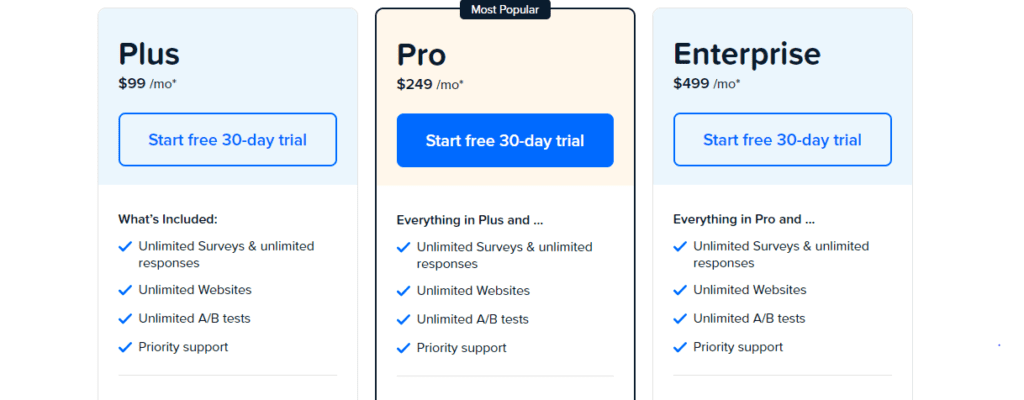
Mouseflow: The ultimate heatmap tool
Mouseflow combines heatmap analysis with session recordings to give businesses an accurate picture of user behavior. It tracks clicks, scrolls, mouse movements, and interactions on forms that help you understand what is and isn’t working on your website.
Plus, you can replay individual user sessions on Mouseflow to see how visitors navigate your site. Conversion funnels and form analytics help identify where people might drop off in a conversion process. This proves useful for optimizing user experience, fixing website problems, and converting more by targeting problem areas.

User Testing Tools
One website optimization tool is user testing tools. User testing tools in CRO represent platforms through which a business can understand how users interact with their website, product, or application. Businesses use these tools to analyze how users behave and collect their usability feedback to identify usability issues that influence conversion rates.
Testing with real users will give companies immediate insight into what works and what doesn’t. This enables companies to make more data-driven decisions when improving UX and increasing conversions.
Some of the user testing tools are described below:
User testing: a website optimization tool
It allows a business to get actual and real-time feedback from people using the website, app, or product. You can make tasks or questions that you would like the users to do, then watch video recordings of how they navigate your site. It also provides live interviews to ask follow-up questions for you to understand their experience better.
User testing helps pinpoint potential issues such as confusing design, broken links, or unclear navigation. Based on these discoveries, the business can then make smart adjustments to optimize user experience and conversion rates. It is, after all, a pretty simple, effective method of examining your site through your customers’ eyes.
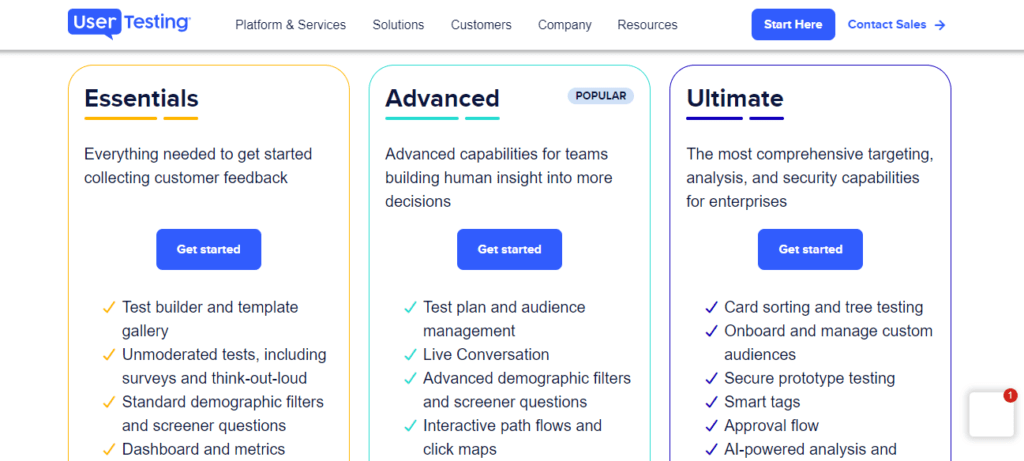
Lookback: a famous user testing tool for your business
Lookback is a user testing tool through which genuine feedback on how real users will engage with your website, app, or product in real time can be collected easily. You can go live and interview users, record user sessions, and gather valuable insights to improve your design or functionality.
With features including screen sharing, audio, and video recording to capture user reactions, Lookback helps you understand users’ behavior and make data-driven decisions to improve your product’s overall experience.

Zoom in to your users by “UserZoom”
With UserZoom and its user research platform, you can understand the people interacting with your website, app, or product. It lets you administer usability tests, surveys, and interviews with real users. Powerful analytics and reporting tools gather feedback, measure user satisfaction, and analyze areas for improvement.
UserZoom supports moderated and unmoderated testing, making it flexible enough to meet diverse research needs. The platform will assist you in making informed decisions based on real user experience, enabling you to craft products that are easier to use and more enjoyable for your audience.
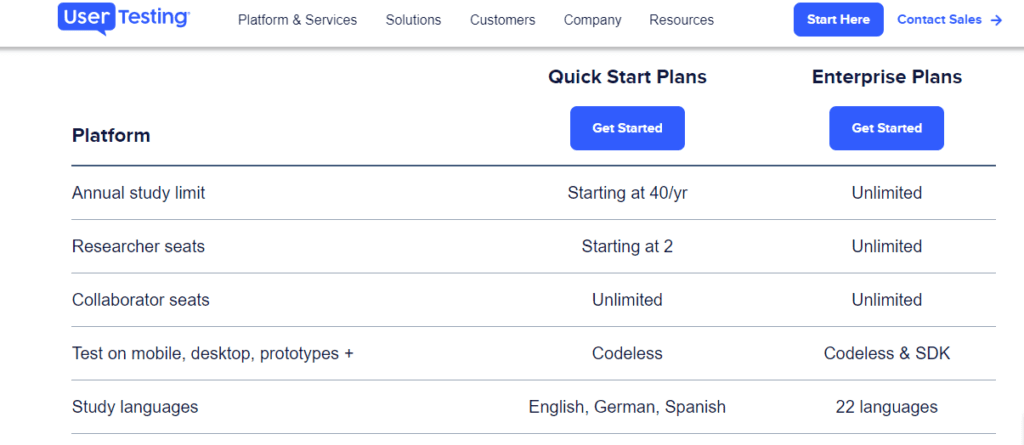
Analytics Tool for CRO
With a CRO analytics tool, you can monitor your website’s conversion metrics. You can see where visitors click, scroll, and spend time on every page. This data helps users identify problems, test different versions of their sites, and observe what they need to do to drive better conversions.
It gives you insights, allowing you to make smart decisions, optimize your site, and generate more sales or sign-ups. With a CRO analytics tool, you can continually work on improving your website’s performance, leading to more business success.
Following are some analytics tools that you can use to enhance the CRO of your website:
Google Analytics: The leading analytic tool
Google Analytics is a good, powerful tool for tracking and reporting website traffic. It helps businesses understand where users are interacting with their websites. It gives valuable insight into how customers behave, including how visitors find your site, the pages they go through, and how long they spend on those pages.
Google Analytics is particularly helpful to any eCommerce business because it allows it to identify areas for improvement in the sales funnel. One can see which products sell best, where users tend to fall off during checkout, and what marketing channels drive the most traffic and sales.
With this kind of data, companies will be able to improve their websites and gain critical insights during proper marketing, which helps firms make data-driven decisions for revenue maximization. For more details, read our detailed blog post on Google Analytics Tips for Enhanced CRO(Conversion Rate Optimization) and Data-Driven Results.
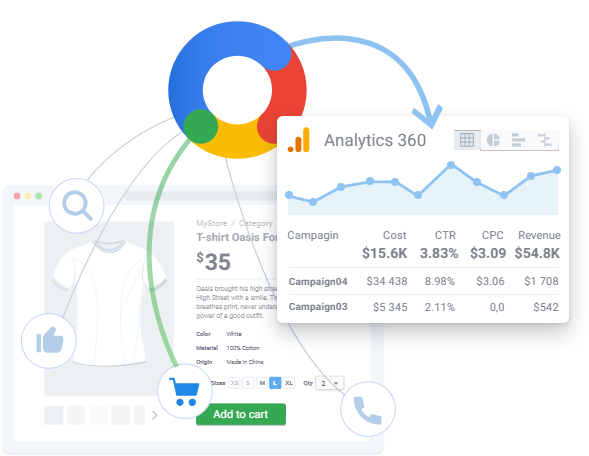
Adobe Analytics: another leading tool in analytics
Adobe Analytics is a good tool for businesses to track their website traffic and dig deep into the more discreet customer behaviors. For the eCommerce company, it gives rich data on how users navigate the site, which products are viewed, and where the dropping-off points exist in the buying process. It even lets you track your conversions, monitor the effectiveness of specific products, and review your marketing efforts.
Other features include advanced segmentation and reporting, which allow a business to focus its strategy on the right customer segments. With this intelligence, an eCommerce business can optimize its website, improve its user experience, and increase sales.

Matomo: Analytics tool for CRO
Matomo is an open-source analytics tool that helps businesses monitor and analyze website traffic while fully retaining data ownership. For an eCommerce business, this would give detailed insights into user behavior,, such as how visitors interact with products, where they tend to drop off, and what pages induce the most engagement among their users.
Matomo emphasizes privacy by ensuring businesses strictly comply with all data protection laws. Through the use of Matomo, e-commerce stores can better optimize their websites, facilitate the best user experiences, and make intelligent decisions based on data to grow sales, entirely in control of their data. Matomo starts at only 22 EUR per month for businesses.
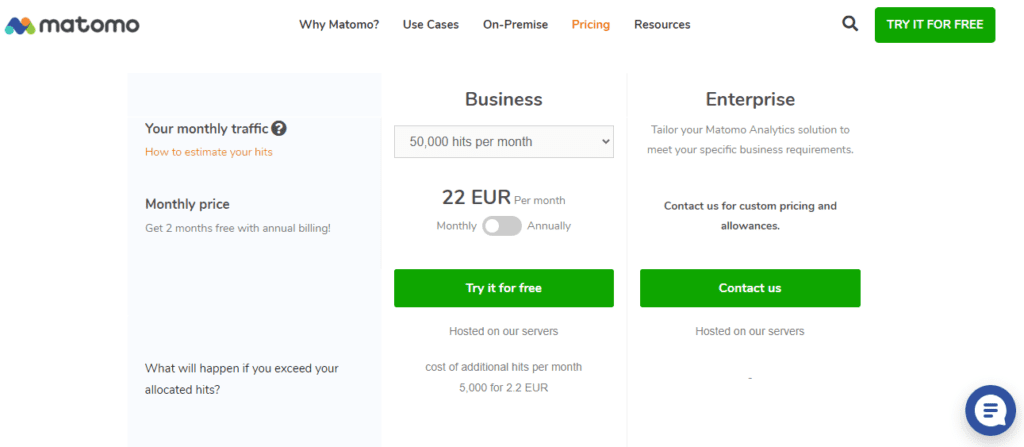
Other CRO tools that are essential for your e-commerce business
Some other CRO tools that will help you in website optimization are discussed below:
Personalization tools
Personalization tools are software or platforms that enable businesses to customize content, product recommendations, and user experiences according to individual user behavior, preferences, and data. They gather insights into user interactions, such as browsing habits, purchase history, location, and demographics, and use that information to deliver customized experiences.
Dynamic yield:
Dynamic Yield is a personalization platform that makes all content on a website and product recommendations unique for every user. This helps companies increase engagement, conversion rates, and, of course, customer experience.
Kameleoon:
Kameleoon empowers businesses to create a high-quality CUSTOMIZED EXPERIENCE based on users’ behavior and adjust the right content for them on their websites, thereby increasing engagement and driving higher conversion rates using data-driven optimization.
Form Optimization Tools
Form Optimization Tools help businesses develop, enhance, and perfect their online forms to encourage user interactions and submissions. Such tools provide accessible interfaces, drag-and-drop builders, customizable templates, and mobile-responsive designs.
Typeform:
Typeform is an interactive form builder that allows for creating interesting and user-friendly forms, surveys, and quizzes to collect data more enjoyably while increasing response rates with its sleek design.
Jotform:
Jotform allows you to create mobile-responsive forms for effective data collection. Its easy drag-and-drop interface makes data management much easier and allows you to easily connect to the most popular tools.
Web Speed Optimization Tools
Website speed is the rate at which a web page loads, after which the page can fully interact with users. It is an important factor affecting user experience since the longer the loading time, the higher the bounce rate and the lower the user satisfaction.

Google PageSpeed Insights:
Google PageSpeed Insights will test your website’s speed and performance on different devices and offer you recommendations for improvement. This will enhance performance and user experience, resulting in a better ranking.
GTmetrix:
GTmetrix is a tool that provides detailed information about your website’s loading issues and speed and offers suggestions on optimizing pages to achieve better load times and improved user experience.
Mobile Speed Optimization Tools
This is widely referred to as improving the loading speed and performance of any website on mobile devices. As smartphone and tablet surfing increases, a website should load quickly on those gadgets so that it continues to engage and entertain users for a longer period.
Google mobile-friendly test:
It tests how well your website performs on smartphones and provides suggestions on how to improve mobile usability so that it works flawlessly on smartphones.
BrowserStack:
BrowserStack is an online testing environment that allows developers to test their applications on real mobile devices and browsers so that compatible rendering can be done across platforms.
Conclusion:
Thus, CRO Tools are very important in an e-commerce business. With tools ranging from A/B testing and heatmaps to analytics and personalization platforms, they study users’ behavior and interest regarding certain products.
With this actual implementation in place, companies can optimize the user experience, streamline workflow, and increase sales.
With the changing landscape of e-commerce, using Conversion Rate Optimization tools will enable businesses to stay competitive, adjust to consumers’ altered needs, and capitalize on incoming traffic best. Growth and staying the course for as long as possible are the keys to digital marketplaces when investing in such approaches.
FAQs
-
What are CRO tools?
Conversion rate optimization (CRO) tools collect data about your website and visitors to help you understand how people use it and identify and test potential changes to increase conversion rates: marketing, e-commerce, and web performance tips.
-
What is CRO for e-commerce?
Conversion Rate Optimization generally refers to enhancing the percentage of visitors to a website who perform desired actions, such as making a purchase or signing up for a service. CRO is a core for every e-commerce business, as it maximizes the value of existing traffic and raises the value of revenue and customer satisfaction.
-
Is Google Analytics a CRO tool?
Google Analytics is a powerful tool for tracking and reporting website traffic. It helps businesses understand where users are interacting with their websites. It gives valuable insight into how customers behave, including how visitors find your site, the pages they go through, and how long they spend on those pages.
-
What are the different tests done by CRO?
A/B testing can increase conversions on landing pages by as much as 30%. Data analysis, such as click rates, sign-ups, or purchases, will enable businesses to know which version more persuasively elicits the desired behavior for users. This process allows companies to make decisions based on user behavior, increasing conversion rates.
-
How do you analyze CRO?
With a CRO analytics tool, you can monitor your website’s conversion metrics. You can see where visitors click, scroll, and spend time on every page. This data helps users identify problems, test different versions of their sites, and observe what they need to do to drive better conversions.

